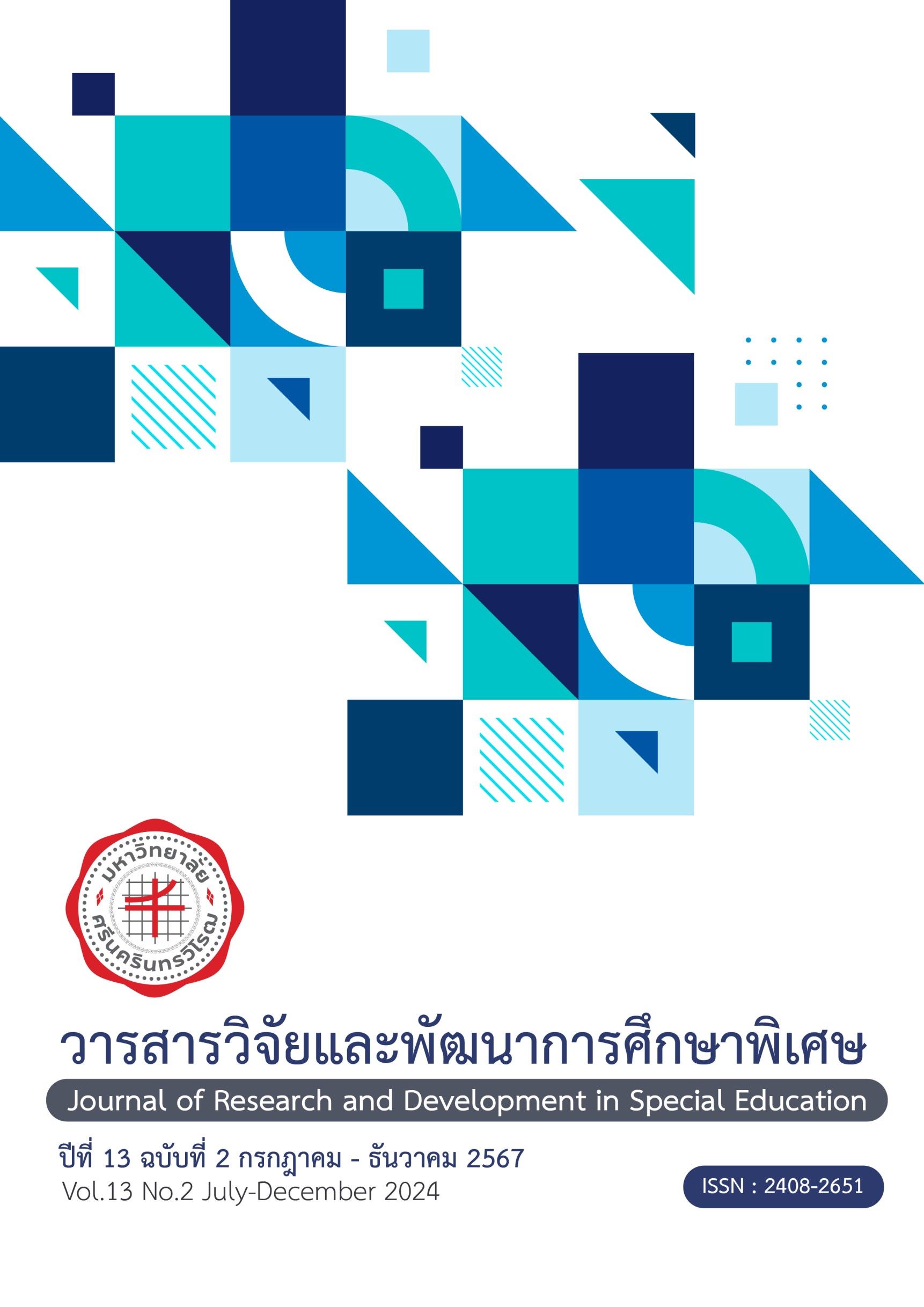แนวทางการให้บริการดนตรีบำบัดสำหรับผู้ที่มีความบกพร่องทางการเห็นในโรงเรียนสอนคนตาบอดในประเทศไทย
Keywords:
แนวทางการให้บริการ, ดนตรีบำบัด, ผู้ที่มีความบกพร่องทางการเห็นAbstract
การวิจัยนี้มีวัตถุประสงค์เพื่อศึกษาสภาพและความต้องการของผู้บริหารและครูเกี่ยวกับการให้บริการดนตรีบำบัดสำหรับผู้ที่มีความบกพร่องทางการเห็นในโรงเรียนสอนคนตาบอดในประเทศไทย เพื่อศึกษาประสบการณ์ของนักดนตรีบำบัดในการให้บริการดนตรีบำบัดสำหรับผู้ที่มีความบกพร่องทางการเห็น และพัฒนาแนวทางในการให้บริการดนตรีบำบัดสำหรับผู้ที่มีความบกพร่องทางการเห็นของโรงเรียนสอนคนตาบอดในประเทศไทย โดยสัมภาษณ์บุคลากรในโรงเรียนสอนคนตาบอดในประเทศไทยและนักดนตรีบำบัด รวมทั้งสิ้น 16 คน และนำข้อมูลที่ได้มาวิเคราะห์แบบอุปนัย เพื่อนำข้อมูลมาใช้ในการพัฒนาแนวทางการให้บริการ จากผลการสัมภาษณ์พบว่าบุคลากรในโรงเรียนเล็งเห็นว่าดนตรีบำบัดนั้นมีประโยชน์ต่อการพัฒนาทักษะด้านการฟัง อารมณ์ สมาธิ และพฤติกรรม ส่วนนักดนตรีบำบัดที่มีประสบการณ์ในการให้บริการดนตรีบำบัดกับผู้ที่มีความบกพร่องทางการเห็นได้ให้สัมภาษณ์ว่า เป้าหมายในการให้บริการดนตรีบำบัดกับผู้ที่มีความบกพร่องทางการเห็นนั้น ได้แก่ เป้าหมายเพื่อพัฒนาทักษะด้านการฟัง อารมณ์ และคุณภาพชีวิต โดยส่วนใหญ่จะเป็นการให้บริการแบบเดี่ยว และมีการว่าจ้างนักดนตรีบำบัดทั้งแบบประจำที่มีสวัสดีการ และแบบอิสระที่ได้รายได้มากกว่าแต่ไม่ได้รับสวัสดิการ โดยผลจากการพัฒนาแนวทางพบว่ามีองค์ประกอบ 3 ส่วน ได้แก่ 1) การให้บริการดนตรีบำบัดสำหรับผู้ที่มีความบกพร่องทางการเห็น มีกระบวนการรับเข้าส่งต่อผู้รับบริการ ประเมินผล ตั้งเป้าหมาย และรูปแบบการให้บริการ 2) การทำงานร่วมกันระหว่างนักดนตรีบำบัดและบุคลากรที่เกี่ยวข้อง 3) วิชาชีพดนตรีบำบัดที่ประกอบไปด้วยการว่าจ้าง ค่าตอบแทน และสวัสดิการDownloads
References
กระทรวงศึกษาธิการ. (2551). หลักสูตรแกนกลางการศึกษาขั้นพื้นฐาน พุทธศักราช 2551. https://academic.obec.go.th/images/document/1559878925_d_1.pdf.
กระทรวงศึกษาธิการ. (2552). ประกาศกระทรวงศึกษาธิการ เรื่อง กำหนดประเภทและหลักเกณฑ์ของคนพิการทางการศึกษา. http://law.m-society.go.th/law2016/uploads/
lawfile/20100210_15_14_27_7714.pdf.
Adamek, M. S., & Darrow, A. A. (2018). Music in Special Education. The American Music Therapy Association.
Annesley, L. (2014). The Music Therapist in School as Outsider. British Journal of Music Therapy, 28(2), 36-43. https://doi.org/10.1177/135945751402800207
Bruscia, K. E. (1991). Case studies in music therapy / edited by Kenneth E. Bruscia. Barcelona Publishers.
Creswell, J. W. (2014). Research Design: Qualitative, Quantitative and Mixed Methods Approaches (4th edition). Thousand Oaks, CA: Sage.
Dauber, M. (2011). “What is Essential is Invisible to the Eye” – A Music Therapy Tale of a Young Woman with Visual Impairment. Approaches: Music Therapy & Special Music Education | Special Issue 2011, 20-29.
Hashemian, P. , Mashoogh, N. and Jarahi, L. (2015). Effectiveness of Music Therapy on Aggressive Behavior of Visually Impaired Adolescents. Journal of Behavioral and Brain Science, 5, 96-100. doi: 10.4236/jbbs.2015.53009.
Kahler, E.P., Coleman, J.M., & Molloy-Daugherty, D. (2018). Survey of Music Programs at State Residential Schools for Blind Students. Journal of Visual Impairment & Blindness, 112, 311 - 316.
LaVenture, S. (2007). A parents’ guide to special education for children with visual impairments / Susan LaVenture, editor. American Foundation for the Blind.
Long, R. ., & Giudice, N. . (2010). Establishing and maintaining orientation for mobility. Foundations of Orientation and Mobility. 45–62.
Metell, M., & Stige, B. (2016). Blind spots in music therapy. Toward a critical notion of participation in context of children with visual impairment. Nordic Journal of Music Therapy, 25(4), 300–318. https://doi.org/10.1080/08098131.2015.1081265
Nightingale, E. (2015). An Investigation into Music Therapists’ Clinical Experience of Working with the Visually Impaired. British Journal of Music Therapy, 29(1), 3–17. https://doi.org/10.1177/135945751502900102
Ritter-Cantesanu, G. (2014). Music therapy and the IEP process. Music Therapy Perspectives, 32(2), 152. https://doi.org/10.1093/mtp/miu018
Robb, S. L. (2003). Music Interventions and Group Participation Skills of Preschoolers with Visual Impairments: Raising Questions about Music, Arousal, and Attention. Journal of Music Therapy, 40(4), 266–282. https://doi.org/10.1093/jmt/40.4.266
Uslan, M., Malone, S., & De L’Aune, W. (1983). Teaching Route Travel to Multiply Handicapped Blind Adults: An Auditory Approach. Journal of Visual Impairment & Blindness, 1, 18–20. https://doi.org/10.1177/0145482x8307700106
Waltz, C.F., Strickland, O. and Lenz, E.R. (2010) Measurement in nursing and health research. Springer Publishing Company, New York.
Wilson, B. L. (2002). Models of music therapy interventions in school settings / edited by Brian L. Wilson. (Second edition.). American Music Therapy Association.




